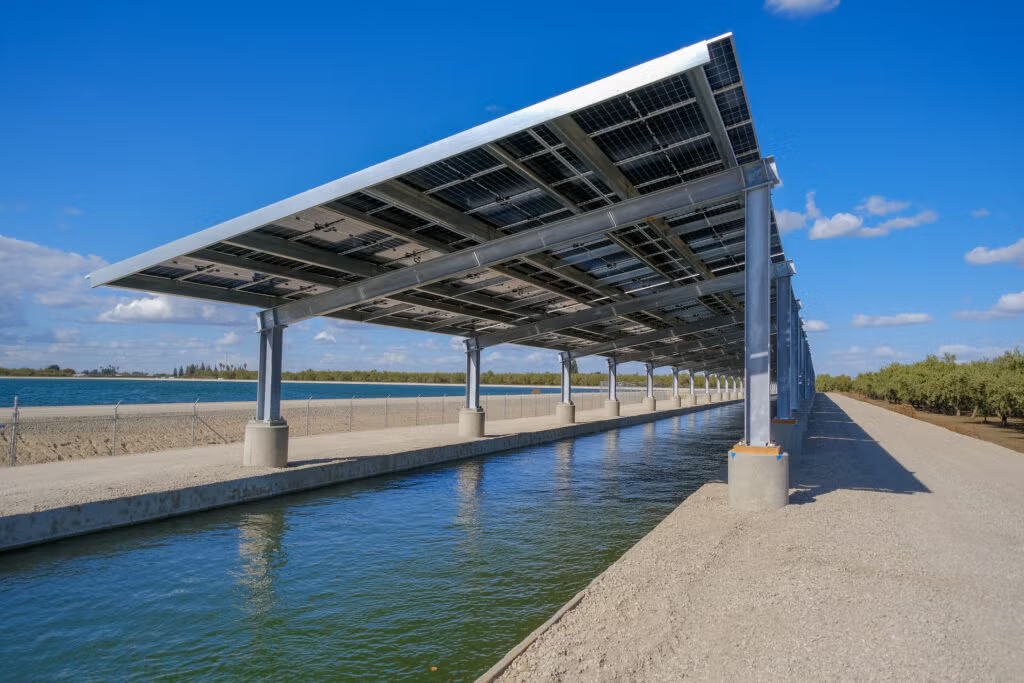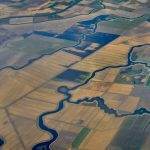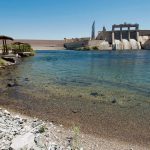- California completes its first solar-over-canal pilot.
- Project Nexus could save water and generate clean power.
- Researchers to study evaporation, efficiency, and energy storage.
Thursday, October 9, 2025 — In August 2025, the Turlock Irrigation District (TID) completed construction on a groundbreaking solar energy project that could reshape how the West manages its most precious resources—water and power. The initiative, known as Project Nexus
completed construction on a groundbreaking solar energy project that could reshape how the West manages its most precious resources—water and power. The initiative, known as Project Nexus , installs solar panels over irrigation canals in California’s Central Valley, producing 1.6 megawatts of renewable electricity while conserving water and improving canal efficiency.
, installs solar panels over irrigation canals in California’s Central Valley, producing 1.6 megawatts of renewable electricity while conserving water and improving canal efficiency.
This $20 million state-funded pilot combines the expertise of TID, the California Department of Water Resources, the University of California, Merced,
combines the expertise of TID, the California Department of Water Resources, the University of California, Merced, and Solar AquaGrid. The project’s design covers both narrow and wide canal sections—ranging from 20 to 110 feet wide—with solar panels suspended above the water. UC Merced researchers began collecting baseline data earlier this year and will continue to study the project’s impacts over time.
and Solar AquaGrid. The project’s design covers both narrow and wide canal sections—ranging from 20 to 110 feet wide—with solar panels suspended above the water. UC Merced researchers began collecting baseline data earlier this year and will continue to study the project’s impacts over time.
Merging Water and Energy.
Project Nexus represents what engineers and policymakers call the “water-energy nexus,” a growing field focused on the interdependence between the two resources. “The water in the canals can help cool the solar panels, making them more efficient, while the panels provide shade that reduces evaporation,” explained UC Merced researchers.
Beyond energy generation, the solar coverings may help limit algae growth and improve water quality by reducing sunlight exposure. If successful, the model could be replicated across California’s extensive water conveyance network, transforming how the state balances its renewable energy and water conservation goals.
Statewide Implications.
According to a UC Merced study, covering California’s 4,000 miles of public water delivery canals with solar panels could save up to 63 billion gallons of water annually—enough to irrigate 50,000 acres of farmland or supply 2 million people each year. The same study estimated that such coverage could generate 13 gigawatts of clean power, more than half of the new capacity California needs to meet its 2030 decarbonization targets.
The panels installed over TID’s canals are expected to supply renewable power to homes, farms, and canal operations in Stanislaus County. The project also incorporates 75-kilowatt iron-flow batteries for energy storage, allowing electricity to flow even when sunlight is limited.
A Growing National Trend.
Project Nexus follows a similar installation completed by the Gila River Indian Community near Phoenix, Arizona, in late 2024—the first solar-canal array in the United States. Additional projects are under development in Arizona and Oregon, supported by grants from the U.S. Bureau of Reclamation and the Inflation Reduction Act.
Proponents say this approach offers major benefits for arid regions where drought and land-use conflicts make traditional solar farms harder to approve. “Why disturb land that has sacred value when we could just put the solar panels over a canal and generate more efficient power?” said David DeJong, director of the Pima-Maricopa Irrigation Project.
Cost and Complexity.
Despite the promise, solar-over-canal projects remain more expensive and technically challenging than ground-mounted systems. The structures require more steel and concrete, and wide canals may need extra supports that complicate water flow. Still, engineers argue that the long-term savings—from reduced water loss, lower maintenance costs, and efficient energy production—may offset the upfront costs over time.
For the Turlock Irrigation District, founded in 1887 as California’s first publicly owned irrigation district, Project Nexus reflects a commitment to both innovation and tradition. As the state works toward its mandate for 60 percent renewable electricity by 2030 and 100 percent carbon-free power by 2045, projects like this offer a glimpse of how water infrastructure might help generate clean energy rather than just deliver it.
UC Merced researchers will release full findings after the first irrigation season, evaluating evaporation savings, water quality changes, and overall system efficiency.
Image credit: Turlock Irrigation District – Project Nexus website.
FAQ
What is Project Nexus?
Project Nexus is a pilot program by the Turlock Irrigation District (TID) to install solar panels over irrigation canals. It is the first project of its kind in California and serves as a model for integrating renewable energy with water conservation.
Who are the partners?
The project is a collaboration among TID, the California Department of Water Resources, UC Merced, and Solar AquaGrid.
How much power does it generate?
The installation produces about 1.6 megawatts of renewable power and includes 75-kilowatt iron-flow batteries for energy storage.
How does it save water?
The solar panels provide shade and wind protection, which can reduce evaporation and slow aquatic plant growth, potentially improving water quality.
Why not build solar farms on land?
Installing solar panels over existing canals avoids disturbing farmland or sensitive ecosystems, shortens permitting time, and makes use of infrastructure that already exists.
What are researchers studying?
UC Merced scientists are measuring water evaporation, panel efficiency, maintenance costs, and energy output to evaluate the overall benefits of solar-over-canal systems.
Could this expand statewide?
If successful, similar projects could be replicated across California’s 4,000 miles of canals, saving billions of gallons of water and generating large amounts of renewable power.






I agree. It seems to me this would also cut down on evaporation issues and debris getting into the system, too.